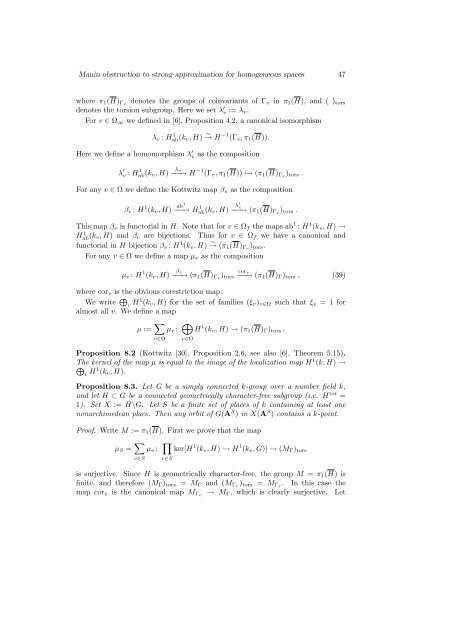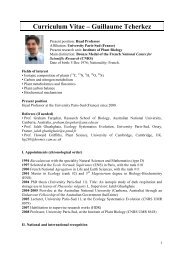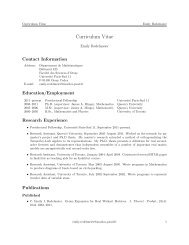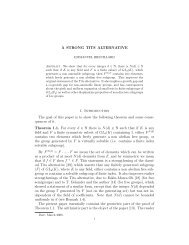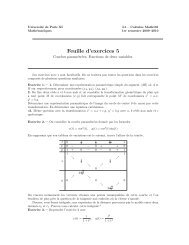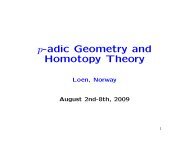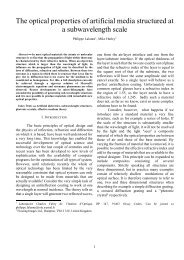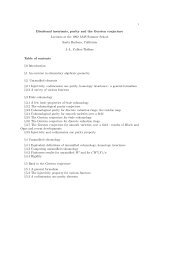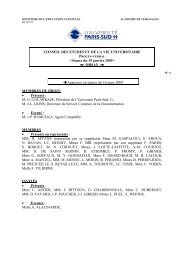Manin obstruction to strong approximation for homogeneous spaces
Manin obstruction to strong approximation for homogeneous spaces
Manin obstruction to strong approximation for homogeneous spaces
Create successful ePaper yourself
Turn your PDF publications into a flip-book with our unique Google optimized e-Paper software.
<<strong>strong</strong>>Manin</<strong>strong</strong>> <<strong>strong</strong>>obstruction</<strong>strong</strong>> <<strong>strong</strong>>to</<strong>strong</strong>> <strong>strong</strong> <strong>approximation</strong> <strong>for</strong> <strong>homogeneous</strong> <strong>spaces</strong> 47where π 1 (H) Γv denotes the groups of coinvariants of Γ v in π 1 (H), and ( ) <<strong>strong</strong>>to</<strong>strong</strong>>rsdenotes the <<strong>strong</strong>>to</<strong>strong</strong>>rsion subgroup. Here we set λ ′ v := λ v .For v ∈ Ω ∞ we defined in [6], Proposition 4.2, a canonical isomorphismλ v : H 1 ab(k v , H) ∼ → H −1 (Γ v , π 1 (H)).Here we define a homomorphism λ ′ v as the compositionλ ′ v : H 1 ab(k v , H)λ v−−→ H −1 (Γ v , π 1 (H)) ↩→ (π 1 (H) Γv ) <<strong>strong</strong>>to</<strong>strong</strong>>rs .For any v ∈ Ω we define the Kottwitz map β v as the compositionβ v : H 1 (k v , H) −−→ ab1Hab(k 1 v , H)λ ′ v−−→ (π 1 (H) Γv ) <<strong>strong</strong>>to</<strong>strong</strong>>rs .This map β v is func<<strong>strong</strong>>to</<strong>strong</strong>>rial in H. Note that <strong>for</strong> v ∈ Ω f the maps ab 1 : H 1 (k v , H) →H 1 ab (k v, H) and β v are bijections. Thus <strong>for</strong> v ∈ Ω f we have a canonical andfunc<<strong>strong</strong>>to</<strong>strong</strong>>rial in H bijection β v : H 1 (k v , H) ∼ → (π 1 (H) Γv ) <<strong>strong</strong>>to</<strong>strong</strong>>rs .For any v ∈ Ω we define a map µ v as the compositionµ v : H 1 (k v , H)β v−−→ (π 1 (H) Γv ) <<strong>strong</strong>>to</<strong>strong</strong>>rscor v−−→ (π 1 (H) Γ ) <<strong>strong</strong>>to</<strong>strong</strong>>rs , (39)where cor v is the obvious corestriction map.We write ⊕ v H1 (k v , H) <strong>for</strong> the set of families (ξ v ) v∈Ω such that ξ valmost all v. We define a map= 1 <strong>for</strong>µ := ∑ v∈Ωµ v : ⊕ v∈ΩH 1 (k v , H) → (π 1 (H) Γ ) <<strong>strong</strong>>to</<strong>strong</strong>>rs .Proposition 8.2 (Kottwitz [30], Proposition 2.6, see also [6], Theorem 5.15).The kernel of the map µ is equal <<strong>strong</strong>>to</<strong>strong</strong>> the image of the localization map H 1 (k, H) →⊕v H1 (k v , H).Proposition 8.3. Let G be a simply connected k-group over a number field k,and let H ⊂ G be a connected geometrically character-free subgroup (i.e. H <<strong>strong</strong>>to</<strong>strong</strong>>r =1). Set X := H\G. Let S be a finite set of places of k containing at least onenonarchimedean place. Then any orbit of G(A S ) in X(A S ) contains a k-point.Proof. Write M := π 1 (H). First we prove that the mapµ S = ∑ ∏µ v : ker[H 1 (k v , H) → H 1 (k v , G)] → (M Γ ) <<strong>strong</strong>>to</<strong>strong</strong>>rsv∈Sv∈Sis surjective. Since H is geometrically character-free, the group M = π 1 (H) isfinite, and there<strong>for</strong>e (M Γ ) <<strong>strong</strong>>to</<strong>strong</strong>>rs = M Γ and (M Γv ) <<strong>strong</strong>>to</<strong>strong</strong>>rs = M Γv . In this case themap cor v is the canonical map M Γv → M Γ , which is clearly surjective. Let


